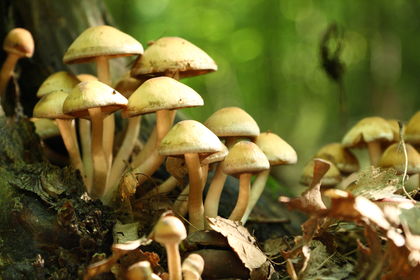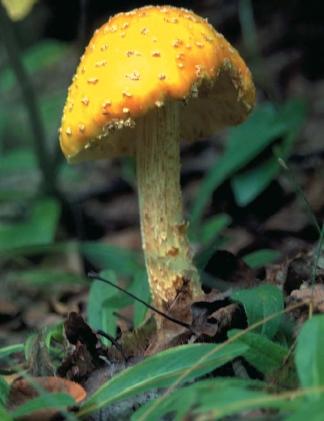Fungi

Fungi (plural of fungus) are one of the five kingdoms of organisms. Kingdoms are the main divisions into which scientists classify all living things on Earth. The other kingdoms are: Monera (single-celled organisms without nuclei), Protista (single-celled organisms with a nucleus), Plantae (plants), and Animalia (animals).
Fungi constitute a large and diverse group of organisms. The kingdom of fungi is divided into four major groups: conjugating fungi, sac fungi, club fungi, and imperfect fungi. Mushrooms, molds, yeasts, and mildew are all fungi. Biologists have estimated that there are more than 200,000 species of fungi in nature, although only about 100,000 have been identified so far. The scientific study of fungi is called mycology.
General characteristics
The different groups of fungi have different levels of cellular organization. Some groups consist of single-celled organisms that have a single nucleus per cell. (A nucleus is a membrane-enclosed structure within a cell that contains the cell's genetic material and controls its growth and reproduction.) Other groups consist of single-celled organisms in which each cell has hundreds or thousands of nuclei. Still others consist of multicellular organisms that have one or two nuclei per cell. The bodies of multicellular fungi usually consist of slender, cottony filaments called hyphae. A mass of hyphae is called a mycelium. The mycelium carries on all the life-maintaining processes of the organism, including sexual reproduction (in most species).
Unlike plants, fungi do not contain chlorophyll (green pigment) and thus cannot create their own food through photosynthesis (the chemical process by which plants containing chlorophyll use sunlight to convert carbon dioxide and water to carbohydrates, releasing oxygen as a byproduct).
Most species of fungi grow on land and obtain their nutrients from dead organic matter. Most species feed by secreting enzymes, which partially break down the food. The fungi then absorb the partially digested food to complete digestion internally. Because fungi (along with bacteria) help decompose dead plants, animals, and other organic matter, they serve an important ecological role. They release large amounts of carbon dioxide into the atmosphere and recycle nitrogen and other important nutrients for use by plants and other organisms.
Some fungi are parasites, living in or on another organism (called a host) from which they obtain their nutrients. This relationship usually harms the host. Such parasitic fungi usually have specialized tissues called haustoria that penetrate the host's body. Most of the diseases that afflict agricultural plants are caused by parasitic fungi. Some examples are corn smut, black stem rust of wheat and barley, and cotton root rot. Some species of fungi also can parasitize animals. Fungi that parasitize humans cause diseases such as athlete's foot, ringworm, and yeast infections.
Words to Know
Carbohydrate: A compound consisting of carbon, hydrogen, and oxygen found in plants and used as a food by humans and other animals.
Hyphae: Slender, cottony filaments making up the body of multicellular fungi.
Nucleus: Membrane-enclosed structure within a cell that contains the cell's genetic material and controls its growth and reproduction.
Parasite: Organism living in or on another organism (called a host) from which it obtains nutrients.
Photosynthesis: Chemical process by which plants containing chlorophyll use sunlight to convert carbon dioxide and water to carbohydrates, releasing oxygen as a by-product.
Symbiosis: Close relationship between two organisms of different species, which often benefits each member.
Conjugating fungi
There are about 600 species of conjugating fungi. Most species are land-based and feed on organic matter, although there are a few parasitic species. The algaelike conjugating fungi have a continuous mycelium containing hundreds or thousands of nuclei, with no divisions between them. Species of conjugating fungi cause potato blight, downy mildew, black bread mold, and water mold (which affects dead leaves and sticks in water).
Sac fungi
Sac fungi are so-named because many species in this group reproduce sexually by forming a spore-filled structure called an ascus, which means literally "a sac." This large group of fungi includes many species

that are beneficial to humans. For example, yeasts are a major group of sac fungi. Different yeasts are used by bakers, brewers, and vintners to make their bread, beer, or wine. Truffles, regarded as a food delicacy, are underground sac fungi that grow in association with tree roots.
Some species of sac fungi appear as blue-green molds on fruits, vegetables, and cheeses. Several other species are important for the making of cheeses, such as blue cheese.
Some other sac fungi cause plant diseases. These include chestnut blight (a disease that virtually wiped out the American chestnut as a mature forest tree) and Dutch elm disease.
Lichens
A lichen is the product of a symbiotic (mutually beneficial) relationship between fungi and blue-green or green algae. The resulting structure resembles neither species. Typically, the algae supply carbohydrates to the fungi and the fungi supply nitrogen and other nutrients to the algae. Lichens can be very colorful, ranging from bright reds and oranges to yellows and greens, with white, gray, and black hues.
Many lichens can inhabit harsh environments and withstand prolonged periods of drought. In the temperate region of North America, lichens often grow on tree trunks and bare rocks and soil. In Antarctica, they have been found growing upon and within rocks. In the Arctic, the lichen species commonly known as reindeer mosses are important in the diets of caribou and reindeer.
Club fungi
Club fungi species reproduce sexually by forming spores on top of club-shaped structures called basidia. The club fungi are believed to be closely related to the sac fungi. This large group includes species that are known as mushrooms, toadstools, earthstars, stinkhorns, puffballs, jelly fungi, coral fungi, and many other interesting names. Some species, such as the rusts and smuts, cause disease in agricultural grains. Other species, such as the fly agaric, produce chemical hallucinogens (chemicals that induce visions) and have been used by numerous cultures in their religious ceremonies.
A significant species of club fungi is called mycorrhizae, which means "fungus root." Mycorrhizal fungus form a symbiotic relationship with many types of plant roots. (Symbiosis is the close association between two organisms of different species, which often benefits each member.) The fungus typically supplies nitrogen-containing compounds to the plant, and the plant supplies carbohydrates and other organic compounds to the fungus. Mycorrhizal fungus are very important for the growth of orchids and many trees, including pines and beeches.
Imperfect fungi
Mycologists have never observed the sexual reproduction of fungi in the imperfect fungi group. Since this part of their life cycle is missing, they are referred to as imperfect fungi. These fungi may have lost their sexual phase through the course of evolution. Species in this group produce plant and animal diseases. Athlete's foot and ringworm in humans are caused by imperfect fungi.
Some species in this group appear as blue-green molds on fruits, vegetables, and cheeses. Several other species are important for the making of cheeses such as blue cheese, Roquefort, and Camembert. Certainly the best known product obtained from this group of fungi is penicillin, the first widely used antibiotic. Penicillin was first discovered in the mold Penicillium notatum by Scottish bacteriologist Alexander Fleming (1881–1955) in 1928. Scientists now know it is produced by other species in this group, as well.
[ See also Fermentation ; Hallucinogens ; Parasite ; Yeast ]
thank you
Thanks . (: